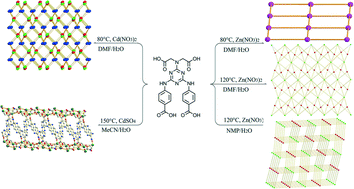A series of metal–organic frameworks containing diverse secondary building units derived from a flexible triazine-based tetracarboxylic ligand†
Abstract
Five new coordination polymers, {[Zn2(CCTA)(DMF)2]·(DMF)·(H2O)2}n (1), {[Zn2.5(CCTA)(OH)(H2O)]·(DMF)·(H2O)}n (2), {[Zn2(CCTA)(H2O)3]·(NMP)2·(H2O)3}n (3), {[Cd4(CCTA)2(DMF)4(H2O)2]·(H2O)6}n (4) and {[Cd4(CCTA)2(H2O)4]·(H2O)4}n (5), (H4CCTA = 2,4-bis(4-carboxyphenylamino)-6-bis(carboxymethyl)amino-1,3,5-triazine, DMF = N,N′-dimethylformamide, NMP = N-methyl-2-pyrrolidone), have been solvothermally synthesized and contain diverse secondary building units (SBUs). Due to various coordination modes and different conformations of the flexible H4CCTA ligand, the five complexes exhibit different topologies. Complex 1 has a two-dimensional (2D) structure with (4,4)-sql topology constructed with tetranuclear zinc clusters. Complex 2 also possesses a 2D framework with an unprecedented (418·610)(45·6)2 point symbol based on pentanuclear zinc clusters. Complex 3 shows a three-dimensional (3D) framework with PtS topology, containing linear tetranuclear zinc clusters. Both complexes 4 and 5 with 3D frameworks are built with rare infinite Cd–O–Cd and Cd2O2 rod-shaped SBUs, respectively. Furthermore, complex 4 could be described as a 4-connected uninodal umc net, instead of the pillared-layer structure of complex 5.


 Please wait while we load your content...
Please wait while we load your content...